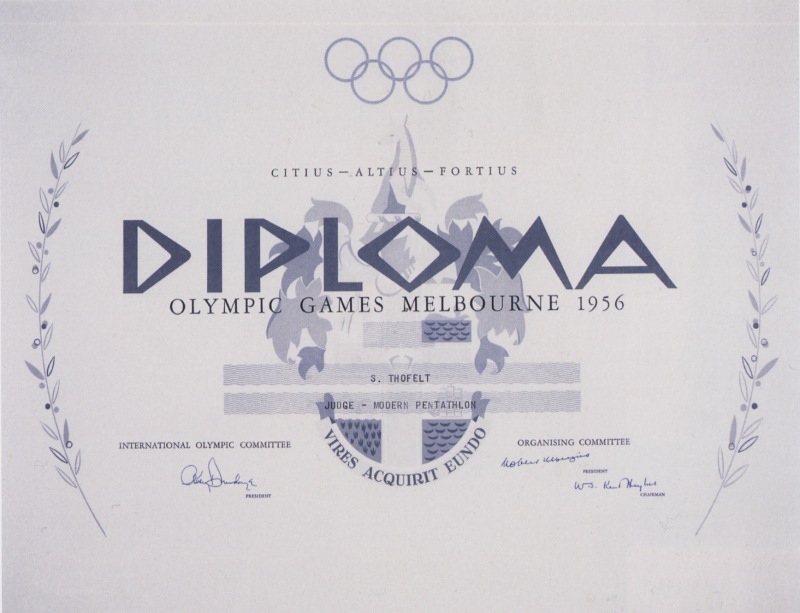Diploma

| Size: | 58 x 44 cm | ||
|---|---|---|---|
| Design by: | unknown |
||
| Printed by: | unknown | ||
| Signed by: | IOC President A. Brundage and Organising Committee President and Chairman |
||
| Copies: | 4.000 | ||
Diploma 1956 Melbourne
The final choice of a design for the diploma incorporated the Coat-of-Arms of the City of Melbourne with its motto Vires Acquirit Eundo*, from an engraved die. Imposed over the Coat-of-Arms was the Olympic motto, then the words " Diploma Olympic Games Melbourne 1956," and below these were three lines left for details of place, event and name to be completed.
Beneath the main design were the signatures of Mr. Avery Brundage, the Right Honourable R. G. Menzies, and the Honourable W. S. Kent Hughes, with two branches of wattle surrounding the whole. The Olympic rings were in the top centre, printed in silver and embossed. The inks used were non-greasy moisture set in four shades of grey with black, and blue-black for signatures. The over-all size of the diploma was 23 inches wide by 17½ inches deep, and printed by letterpress on pure white arctic ivory paper. Four thousand were ordered. The original intention was to handwrite the details on each diploma, but due to the numbers involved a faster method was sought and a leading typewriter company produced a machine with specially large type (3/16 of an inch) which was found to be satisfactory and had the advantage of speed and economy.
Diplomas were issued in accordance with Rule
41 of the I.O.C. which provides for them to be given to :
(1) First to sixth individual place-getters,
and members of teams placed one to six.
(2) Non-competitors officially attached
to teams, but only up to a percentage as laid
down
in Rule 36.
(3) International Federation officials
if certified by their Federations.
The completion of the diplomas proved a much longer and more difficult task than anticipated and brought to light a number of interesting points, among them :-
(1) The difficulty of agreement on translation
and spelling of names
(2) The incomplete records kept particularly
of team events
(3) Some International Federations
taking their records back to their headquarters,
which
involved considerable correspondence to settle even minor points
(4) Each team which had exceeded its
Rule 36 quota of officials had to be asked to
nominate
those to be given diplomas. This took several months
(5) Similarly each International Federation
had to be asked to confirm the names of
officiating
members. This also took considerable time to complete
Both the latter points should have been settled before teams and Federations left Melbourne. Diplomas were individually packed in cardboard tubes and sent in bundles of approximately 20 to each National Olympic Committee. Unfortunately some were lost in transit and others damaged ; all were replaced. In the light of experience a smaller diploma would probably have travelled more safely and in better condition.
( Source document: Official
Report 1956, page 101)